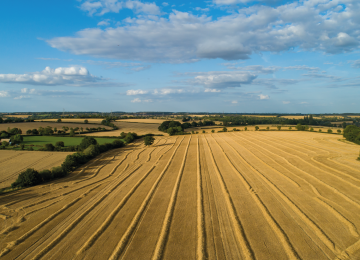Types Of Arable Land
Drafted by: vijaychourey26@gmail.com
Arable land refers to land that is suitable for agricultural cultivation. It is land that is capable of supporting the growth of crops. The types of arable land can vary based on various factors such as soil composition, climate, topography, and water availability. Here are some common types of arable land:
1. Alluvial Soil: Alluvial soil is formed by the deposition of sediment carried by rivers and streams. It is often found in river valleys and floodplains. Alluvial soils are usually fertile and well-drained, making them suitable for a wide range of crops.
2. Loam Soil: Loam soil is a balanced soil type that contains a combination of sand, silt, and clay. It has good drainage and moisture retention properties, making it suitable for various crops. Loam soil is often considered ideal for agriculture due to its favorable texture and nutrient-holding capacity.
3. Sandy Soil: Sandy soil is composed of large particles and has a gritty texture. It drains quickly and has low water-holding capacity, making it less suitable for some crops. However, sandy soil can be suitable for crops that prefer well-drained conditions, such as certain fruits, vegetables, and drought-tolerant plants.
4. Clay Soil: Clay soil has fine particles and a dense, heavy texture. It retains water well but can become compacted and poorly drained. Clay soil is rich in nutrients but may require amendments and proper management to improve its structure and drainage for optimal crop growth.
5. Chalky Soil: Chalky soil, also known as limestone soil, is characterized by high calcium carbonate content. It tends to be alkaline and has good drainage. Chalky soil is suitable for certain crops, but its alkalinity can affect nutrient availability and crop suitability. Some crops that thrive in chalky soil include grapes and certain types of wheat.
6. Peat Soil: Peat soil is formed from partially decomposed organic matter in wetland areas such as bogs and marshes. It is high in organic content and retains moisture well. Peat soil requires careful management and drainage for agriculture, but it can be suitable for crops like potatoes, berries, and certain vegetables.
7. Volcanic Soil: Volcanic soil, also known as volcanic ash soil or Andisol, is formed from volcanic eruptions. It is rich in minerals and nutrients, making it highly fertile. Volcanic soils are often found in areas with volcanic activity, such as volcanic islands or regions near active volcanoes.
8. Saline and Sodic Soil: Saline and sodic soils have high salt content, making them less suitable for most crops. Saline soils have soluble salts that can be damaging to plants, while sodic soils have high levels of sodium. Proper management, such as leaching and soil amendment, is required to make these soils suitable for agriculture.
9. Black Soil: Black soil, also known as black cotton soil or vertisol, is characterized by high clay content and dark color. It has good water retention capacity and is known for its fertility. Black soil is commonly found in regions with a semi-arid to arid climate, such as the Deccan Plateau in India.
10. Mountainous and Highland Soils: Mountainous and highland soils are found in hilly and mountainous regions. They can vary in composition and characteristics based on local conditions and parent materials. These soils can be fertile and suitable for agriculture, but they often present challenges due to erosion, steep slopes, and limited access.
These are some of the common types of arable land. The suitability of a specific type of arable land for agriculture depends on factors such as crop requirements, water availability, climate, and proper soil management practices.
